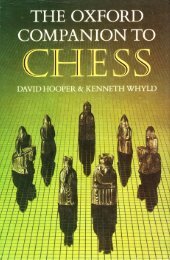Create successful ePaper yourself
Turn your PDF publications into a flip-book with our unique Google optimized e-Paper software.
242 PAULY<br />
perhaps named after L. Paulse. bccause he<br />
pioneered the ue ol lhe ridg\ fianchet<strong>to</strong> (for<br />
Blach) in odervdiations ofrbe spANrsE opsrNcr<br />
455. a line in the rcuR Nrcsrs o.ENrNc introdnced<br />
<strong>by</strong> L. Paulse. in lhe 1870s, and later lavoured <strong>by</strong><br />
NMzowrscH after whom i1 is sonednes namedi<br />
473, sueesstully played <strong>by</strong> L. Paulsen against<br />
rcuscsin the Bnsiol <strong>to</strong>nrnament. 1861, and no* a<br />
standard defence <strong>to</strong> &e Ev^Ns cAMBn A@epted<br />
Gee L. PAULSEN)i 5i4, the ANDE*SSEN .ouNrER-<br />
PAULY, WOLFGANG 08?G1934), @nposer ot<br />
Gemao birth *ho sertled in Ronania whcn he was<br />
tue and came <strong>to</strong> be regarded .s the grealest<br />
problenist ol his adopted @unlry. He is besr<br />
ktrown fo. his rArRy pRoBr-EMs. lor shi.h he war an<br />
earlyenthusiast, andhisMoRE-irovERs; butheliked<br />
<strong>to</strong> cxplore all aspecb ot problem 6mpositio,. and<br />
among othcr things acquired a rep aiion for<br />
NNs. Ile assisred A. c. wEm sith a few<br />
Chiistnas Senes books, notably /ryaue4<br />
(1927). As a young man he tried his hand at<br />
natnemalis and astrooomy, and he is credited<br />
with the di$overy ol a onet (1898 vII): laler he<br />
rhe pawn a! i4 is placed on e3 (fxe3 ep) and ihe<br />
pawn ar e4 is removed fiom the board. When a<br />
pawn is moved <strong>to</strong> lhe eighd rank n nust<br />
inmediarely and as part of the samc movc be<br />
repla@d <strong>by</strong>a quecn. rcok, bishop, or knighl ofthe<br />
samecolou.. a procedure known aspronotion. At<br />
the start oI rhe game eacb player haseiehtpawns,<br />
oneo.eachsquareolhissecondrank,andlbcyare<br />
naned <strong>by</strong> the ,iles on whi.h ihey stand. <strong>The</strong> a-pawn<br />
(slandard notation) is the queen\ rook's paNn or<br />
ORP (desc.iptive noiarion). <strong>The</strong> descriptio. nay<br />
cha.ge: ifan a-pam nales a €p1u]e it becomes a<br />
b-paM. Tbe rooi('s pasn (on ihe a- or h-file)<br />
ahcks onc square, the others wo.<br />
%e<br />
%,<br />
s+ 4 max doub e movc ches<br />
A problem <strong>by</strong> Pady (Der4.h. S.hachbliitt*,<br />
1927). a idMMMH DoUBL<br />
MN r in fonr. Alter the key double-nove. 1 Kc2 &<br />
Kd2. there are lwo variations:<br />
l . .Oh]&Qh3 2d3=N&Nxc6+ K.5 &Oh1 3Kc2&<br />
Kb3 Qxc6 & Ohl ,l lG4 & Ka5 Oas. and 1 . . . Ohl &<br />
orl 2d8=B&Bxl6+ Kc5& OxI6 3Kc2&Kb3Qal&<br />
PAWN. the .hcssman of smallesl siu and lalDc<br />
represenled <strong>by</strong> the symbol P or the neurine A. A<br />
Papn can be noved neilher sideways nor back<br />
wards bui only lo$lrds oo irs 0le, one or rso<br />
squares on its 66t movei one square at a tinc<br />
subsequedtly- Whena capture ismade<strong>by</strong>apawnil<br />
is moved one squ.re diagonally Io ard and notin<br />
anyotherway. So thal a pawn makineilsfirstnolc<br />
camot evade caplure <strong>by</strong> a pawn on a. adjoi.ing<br />
iile the EN pAssN laN qas in<strong>to</strong>duced. Place a<br />
white pawn on c2 and a black pawn on g and if<br />
WbileplaysPe2 e4 Black may capiure ztr pa$,trr:<br />
<strong>The</strong> pawn is the only <strong>chess</strong>man that cannot<br />
capture in thc same dnedion as it can bc movedi<br />
andils pathmay be blocked <strong>by</strong> an enemymani lhe<br />
nan olleasl value, the pavn can threalen pieces,<br />
usually forcing thcm <strong>to</strong> Nilhdrawi thcsc charactcrislics.<br />
its slow pace, its inabilily lo retreat (<strong>to</strong><br />
@rrect a rash .dvance), and the possibiliry oi<br />
promo(oo are thc basis oI most ot rhe gamc's<br />
strategy: the pawn lo.mation dictates the cous€ ol<br />
play. (see s.Eools oF csBs ) on account ol<br />
improved techniquelhe los ol ap.vnnregarded<br />
inoreseriouslythan i. formqtimesandrARrA(ow<br />
.R could sritc in the 1920s,'Neverlosc apaNn and<br />
you will treverlosea gane. Begi!.eB olte. ignore<br />
tbis advice in order 10 locl lhen pieces id conbar.<br />
Th. nanc derivcs from thc,^nglo-F encn word<br />
1o", and ultinarelyflomadi.ecttranslationof the<br />
Arabic vord b"/drl, a <strong>to</strong>ol soldier. h lhe old eame<br />
the pawn could be promored only ro a rrRziN or<br />
$Rs. Neitncr in sHArkNr nor in early EuropcaD<br />
<strong>chess</strong> could the pawn be adva.ced two squares on<br />
ns lirsl move, an innovadon th.t app.rendy dates<br />
PAWN AND MOVE, a handicap thal consisls ol<br />
playing Black and removing the pawn at r belore<br />
rhe starr ol play. <strong>The</strong>se aere the rine honoured<br />
odds fr€queDtly offcrcd <strong>by</strong> prtr,,rDoR, DES<br />
.EdEtLEs, and othe. leading masterollbc past.<br />
<strong>The</strong>y rarely played even. louooNNNs was pro<br />
bably the last player sho could hold mosr ol the<br />
besl llayer of his timc at these odds. He dicd in<br />
1840 paNn and move belte. than any English<br />
playel. In 1860 MoRpEy offered pawn and move <strong>to</strong>




